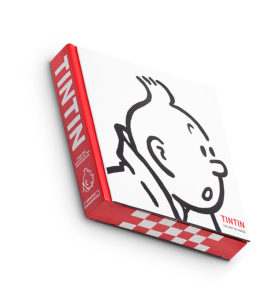Writers: Michel Daubert, Michael Farr
Artist: Hergé
Colorist: Hergé
Letterer: Hergé
Cover Artist: Hergé
Publisher: Abrams ComicArts
It’s surprising how little Georges Remi (1907-83) — better known as Hergé — actually told the world about his most famous creation. For millions of comic book fans, Tintin is a young reporter who happens to be single and European. There really is little else to define him, with no revelations about his childhood, parentage, love life, likes, dislikes, or religious beliefs. None of this information matters, strictly speaking, but it does seem strange given the relatively self-contained mini-universe he otherwise resides in.
Spread across 24 novels, from his first slapstick and clumsy trip to the Soviet Union to the final Tintin and the Picaros, the young lad’s adventures have been pored over by children and young adults the world over, with little thought given to the man who brought these characters to life. This is troubling, given Hergé’s undeniable influence — thanks to his ligne claire or “clear line” style — on generations of artists and illustrators. Journalist Michel Daubert makes a fabulous attempt to rectify that, though, via access to the astonishing collection of the Hergé Museum in Louvain-la-Neuve, Belgium.

This is the kind of book that works not because of an attempt to demystify an artist (because it teeters too much into the realm of hagiography to accomplish that) but because the material it draws upon is so endlessly fascinating for anyone familiar with the world of Tintin. There are some valuable insights, such as how Hergé was influenced by the cinema of the Marx Brothers and Georges Méliès, which helps to place familiar titles such as Destination Moon and Explorers on the Moon in a new light. For the most part though, it is photographs from the collection alone that make this a book worth owning.

For readers who haven’t visited the museum, which reportedly commissioned this book, it follows the structure of seven rooms housed within that structure. Each focuses on a specific aspect of Hergé’s life and work, from information about the building to the artist’s early years as a street urchin, the evolution of his now iconic characters from rough sketches to final versions, actual events that informed the stories, and the success of the books followed by the fame they bought their creator. The final chapter is given over to covers and blurbs for every title, which makes for a pleasant dose of nostalgia. Through it all, Daubert peppers his anecdotes with diagrams, photographs, discarded drawings, and models of places, objects, and events that all helped bring Tintin’s world to life.
There are fascinating lessons here, especially on the development of Hergé’s art, and clues on why narratives that seem so simple ended up being accepted across language and culture.
Clocking in at over 450 pages, this is the kind of companion that can make longtime fans very happy and compel new readers to pick up the books again. Either way, they are both good reasons for why anyone who has ever liked the improbable escapades of that intrepid reporter should pick up a copy. Here’s the most interesting thing I learned: one can tell the difference between the Thompson Twins by looking at their mustaches!




